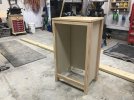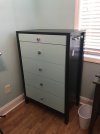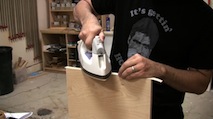Can someone school me on edge-banding? I have never used it, any of it. I see the stuff at Lowes, about $7 a roll, and stuff online for much more... Is there a quality difference, or are you paying for convenience?
I am building a really simple nightstand, out of mostly leftover materials, for my daughter. She has some older Ikea furniture in her room (was actually mine, bought about 10/15 years ago) that is solid pine. My mom recently painted the two dressers, and I am building a nightstand to match. That said, since this is nothing special furniture wise, I decided to just make the drawer boxes from 3/4" ply, pocket screwed/glued... Trying to determine whether to just round over the top edges a bit, edge band them, or put a thin piece of hardwood (or pine) around the lip (similar to the top, in the picture).


I am building a really simple nightstand, out of mostly leftover materials, for my daughter. She has some older Ikea furniture in her room (was actually mine, bought about 10/15 years ago) that is solid pine. My mom recently painted the two dressers, and I am building a nightstand to match. That said, since this is nothing special furniture wise, I decided to just make the drawer boxes from 3/4" ply, pocket screwed/glued... Trying to determine whether to just round over the top edges a bit, edge band them, or put a thin piece of hardwood (or pine) around the lip (similar to the top, in the picture).


Last edited:

